Blog
The Eyes of Texas Are Upon Me!
The wonder of Texas is that its history is as large as the state. Numerous movies have been made about the Texas Revolution and the image of John Wayne as Davy Crockett defending the Alamo is an iconic portrayal of all that is Texas. As a true Daughter of the Republic of Texas, it was time to make an historical pilgrimage to the towns that were the very center of the Texas Revolution - Gonzales, the Come and Take It city and scene of the first military conflict of the revolution and Goliad, known for the Goliad Massacre in 1836.
For this trip, I was riding shotgun and my son, Scott, was the driver. He is an avid historian so it didn't take much to convince him that this would be an outing he would enjoy. Gonzales is located off I10 about 135 miles west of Houston.  It is one of the earliest settlements in Texas and the first west of the Colorado River. On October 2, 1835, the town was the scene of the first battle of the Texas Revolution when Mexican soldiers were sent to retrieve a small cannon that had been given
It is one of the earliest settlements in Texas and the first west of the Colorado River. On October 2, 1835, the town was the scene of the first battle of the Texas Revolution when Mexican soldiers were sent to retrieve a small cannon that had been given 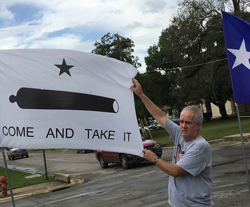 to the settlement for protection. The Texians balked at returning the cannon and readied for battle as they proudly flew a home sewn flag with the image of the cannon and the words: Come and Take It underneath. As the Mexican soldiers approached, the first shots of the revolution were fired. The town remembers the heroic battle with an annual celebration on the first weekend in October and we arrived to find the festivities in full swing with replica flags flown on every corner, carnival rides, and various booths filled with crafts and food to help celebrants enjoy the day.
to the settlement for protection. The Texians balked at returning the cannon and readied for battle as they proudly flew a home sewn flag with the image of the cannon and the words: Come and Take It underneath. As the Mexican soldiers approached, the first shots of the revolution were fired. The town remembers the heroic battle with an annual celebration on the first weekend in October and we arrived to find the festivities in full swing with replica flags flown on every corner, carnival rides, and various booths filled with crafts and food to help celebrants enjoy the day.
Our first stop was at the Gonzales Memorial Museum. This museum opened in 1935 during the year-long 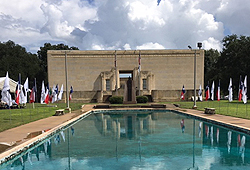 Texas Centennial and commemorates the 32 Gonzales citizens who died at the Alamo. The museum is divided into two exhibition wings and has an outdoor amphitheater and a reflection pool. The first room we entered displayed the smaller, Come and Take It cannon that helped ignite the Texas Revolution. The carriage holding the artillery piece has been reproduced but the cannon has been proven to be the original. Both exhibition areas offer many other
Texas Centennial and commemorates the 32 Gonzales citizens who died at the Alamo. The museum is divided into two exhibition wings and has an outdoor amphitheater and a reflection pool. The first room we entered displayed the smaller, Come and Take It cannon that helped ignite the Texas Revolution. The carriage holding the artillery piece has been reproduced but the cannon has been proven to be the original. Both exhibition areas offer many other 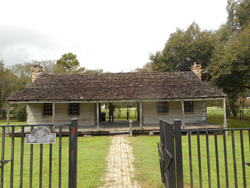 interesting artifacts from old rifles to daily life items used by the settlers in the area and browsing the display cases is well worth the time of the viewer. A short walk from the museum, visitors can see the Eggleston House. The house is a good representation of the type of dog-run cabins that were built during the mid-1800s. Sarah Eggleston and her husband, Horace, had to flee Gonzales to escape Santa Anna's Army. Her husband later fought with General Sam Houston at the Battle of San Jacinto. Sarah gave birth to her first child across the river from the battlefield and later returned to live in the house until her death in 1880.
interesting artifacts from old rifles to daily life items used by the settlers in the area and browsing the display cases is well worth the time of the viewer. A short walk from the museum, visitors can see the Eggleston House. The house is a good representation of the type of dog-run cabins that were built during the mid-1800s. Sarah Eggleston and her husband, Horace, had to flee Gonzales to escape Santa Anna's Army. Her husband later fought with General Sam Houston at the Battle of San Jacinto. Sarah gave birth to her first child across the river from the battlefield and later returned to live in the house until her death in 1880.
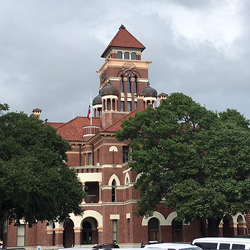 Driving downtown, we could see the Gonzales County Courthouse. This building is on the National Register of Historic Places and is beautifully designed in the Romanesque Revival style. Near the courthouse are many historic houses and buildings. We drove down one of the main streets and my head was spinning around like the girl from
Driving downtown, we could see the Gonzales County Courthouse. This building is on the National Register of Historic Places and is beautifully designed in the Romanesque Revival style. Near the courthouse are many historic houses and buildings. We drove down one of the main streets and my head was spinning around like the girl from 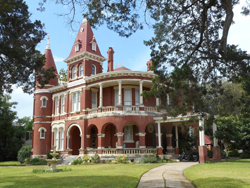 The Exorcist as I tried to see all the beautiful homes on both sides of the street. This district was named as one of the "Best Old House Neighborhoods" by the TV show This Old House. The area has a large inventory of affordable, fixer-upper houses and while the neighborhood is conveniently located near the larger cities of Austin, San Antonio, and Houston it offers the wonderful, low cost of living of small towns. Gonzales is a wonderful place to visit and it looks like it would be an exceptional place to live!
The Exorcist as I tried to see all the beautiful homes on both sides of the street. This district was named as one of the "Best Old House Neighborhoods" by the TV show This Old House. The area has a large inventory of affordable, fixer-upper houses and while the neighborhood is conveniently located near the larger cities of Austin, San Antonio, and Houston it offers the wonderful, low cost of living of small towns. Gonzales is a wonderful place to visit and it looks like it would be an exceptional place to live!
We had planned to drive south to Goliad but as my son has the same wanderlust that I have, we ended up driving 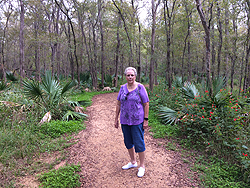 about 15 miles northwest to Palmetto State Park. Texas has many, many state parks and Palmetto is an example of the quality of the various areas. We had been dodging rain showers all morning and were still being followed by black clouds as we left the car in the parking lot to do a little hiking in the area. The trails were great - especially for an older graytripper. They were relatively flat and easy to walk. We got about 1/4 mile on the trail when the rain hit. Now, knowing that there was rain in the area, having a shower on our hike shouldn't have been a problem since we had umbrellas. However, our umbrellas were nice and dry in the trunk of the car! Scott ran back and I shuffled along trailing behind him. Safe and dry inside the car, we decided to maybe take a driving tour of the park and save the hiking for another, sunnier day. The park lives up to its name with many palmetto palms growing in the area. Good place to go for a quiet, relaxing time.
about 15 miles northwest to Palmetto State Park. Texas has many, many state parks and Palmetto is an example of the quality of the various areas. We had been dodging rain showers all morning and were still being followed by black clouds as we left the car in the parking lot to do a little hiking in the area. The trails were great - especially for an older graytripper. They were relatively flat and easy to walk. We got about 1/4 mile on the trail when the rain hit. Now, knowing that there was rain in the area, having a shower on our hike shouldn't have been a problem since we had umbrellas. However, our umbrellas were nice and dry in the trunk of the car! Scott ran back and I shuffled along trailing behind him. Safe and dry inside the car, we decided to maybe take a driving tour of the park and save the hiking for another, sunnier day. The park lives up to its name with many palmetto palms growing in the area. Good place to go for a quiet, relaxing time.
Leaving Palmetto State Park, we headed south to Panna Maria, the oldest Polish settlement in the United States. 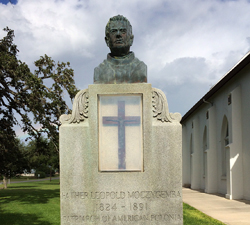 Panna Maria was founded in 1852 by Father Leopold Moczgemba who was born in the Silesian area of Poland. Father Moczgemba encouraged the people of Poland to leave their poor economic conditions and come to a new life in Texas. There was initial disappointment with the land and the dangerous conditions from rattlesnakes to Indian raids but, the emigrants persevered and soon had built a church, school, and post office all of which still operate today. Panna Maria, or Virgin Mary, has always been a small community but almost died out completely until the mid-1960s when many people of Polish descent visited the area for the millennium celebration of Polish Christianity. In 1987, Pope John Paul II made a visit to the United States and was scheduled to visit the church in Panna Maria but itinerary conflicts did not allow enough time and the visit was canceled. The Pontiff did hold a private reception with many of the residents of Panna Maria and told them how everyone in Poland knew the history of Panna Maria, Texas and was proud of the achievements of the Polish families who settled there.
Panna Maria was founded in 1852 by Father Leopold Moczgemba who was born in the Silesian area of Poland. Father Moczgemba encouraged the people of Poland to leave their poor economic conditions and come to a new life in Texas. There was initial disappointment with the land and the dangerous conditions from rattlesnakes to Indian raids but, the emigrants persevered and soon had built a church, school, and post office all of which still operate today. Panna Maria, or Virgin Mary, has always been a small community but almost died out completely until the mid-1960s when many people of Polish descent visited the area for the millennium celebration of Polish Christianity. In 1987, Pope John Paul II made a visit to the United States and was scheduled to visit the church in Panna Maria but itinerary conflicts did not allow enough time and the visit was canceled. The Pontiff did hold a private reception with many of the residents of Panna Maria and told them how everyone in Poland knew the history of Panna Maria, Texas and was proud of the achievements of the Polish families who settled there.
The town of Panna Maria reflects the culture and language of Poland and the impressive 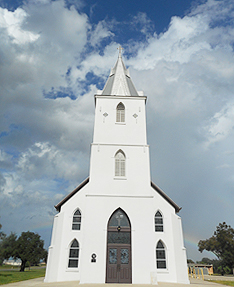 church is beautiful to see. Although there wasn't anyone around, I walked up to the church to see if it might be open. The front of the church is dwarfed by the large, towering white steeple with a bell tower at the top. The curved dark wood gothic doors were closed but surprisingly, they were unlocked and we were able to go inside and view the sanctuary. The beauty of the church is in its simplicity.
church is beautiful to see. Although there wasn't anyone around, I walked up to the church to see if it might be open. The front of the church is dwarfed by the large, towering white steeple with a bell tower at the top. The curved dark wood gothic doors were closed but surprisingly, they were unlocked and we were able to go inside and view the sanctuary. The beauty of the church is in its simplicity. 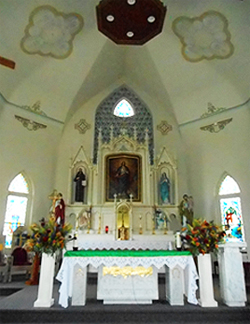 Gleaming white interior walls were contrasted by the pale blue ceiling just as the white facade of the church was contrasted with the blue of the sky. The altar was framed by two stained glass windows, religious statues, and icons. This church is part of the painted churches in Texas and each of them combines the beauty of an inviting house of worship with the inspirational artistry that is used in churches of that area. The church underwent a renovation in 2000 restoring the graceful beauty of the ceiling and large, stained glass mosaic windows. At the front of the church, there is a replica of the Pietá by Michelangelo celebrating the Virgin Mary and Jesus Christ.
Gleaming white interior walls were contrasted by the pale blue ceiling just as the white facade of the church was contrasted with the blue of the sky. The altar was framed by two stained glass windows, religious statues, and icons. This church is part of the painted churches in Texas and each of them combines the beauty of an inviting house of worship with the inspirational artistry that is used in churches of that area. The church underwent a renovation in 2000 restoring the graceful beauty of the ceiling and large, stained glass mosaic windows. At the front of the church, there is a replica of the Pietá by Michelangelo celebrating the Virgin Mary and Jesus Christ. 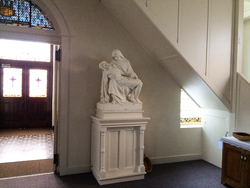 Across from the church, the town is in the process of building a large Polish Heritage museum on the church property and the original post office can be seen across the street from the church. A large, old oak tree stands on the church property and was the site of a Mass, held by a young priest under the tree for seven hundred settlers who had just completed the nine week sailing from Poland to Galveston and the three week foot travel to reach Panna Maria. Many of the Polish descendants of the founding families remain in the area. In 1936, the State of Texas erected a monument near the famed tree and church that recognized Panna Maria as the oldest Polish settlement in Texas.
Across from the church, the town is in the process of building a large Polish Heritage museum on the church property and the original post office can be seen across the street from the church. A large, old oak tree stands on the church property and was the site of a Mass, held by a young priest under the tree for seven hundred settlers who had just completed the nine week sailing from Poland to Galveston and the three week foot travel to reach Panna Maria. Many of the Polish descendants of the founding families remain in the area. In 1936, the State of Texas erected a monument near the famed tree and church that recognized Panna Maria as the oldest Polish settlement in Texas.
As the day was slowly winding down, we began our drive further south to Goliad. Since I am traveling with my son there will be no pictures of food or descriptions of quaint, small town restaurants. He is strictly a "hit the road" kind of guy. I have convinced him that it is better if we go inside McDonald's or Whataburger rather than have me balance a container of french fries, a cheeseburger, and a drink on my lap while he drives. I will have to admit though, my plebeian taste really enjoys fast food and evidently, so do my hips!
Goliad was first established 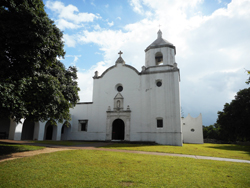 in the late 1700s as the La Bahia Presidio that served the entire Gulf Coast. By 1804, the settlement had one of only two schools in Texas. After the Mexican War of Independence, the name of the village was changed to Goliad. During the Texas Revolution, the Battle of Goliad occurred only days after the siege at the Alamo and over 400 prisoners of war from the Texian Army were killed by the Mexican Army. James Fannin was among those slain on orders from Antonio Lopez de Santa Anna. Fortunately, some prisoners were saved due to the efforts of a Mexican woman who entered the presidio before the massacre, bringing several men out with her and hiding them. She became known as the Angel of Goliad. During the battle of San Jacinto, the men fighting with General Sam Houston could be heard thundering the call to battle with "Remember the Alamo! Remember Goliad!"
in the late 1700s as the La Bahia Presidio that served the entire Gulf Coast. By 1804, the settlement had one of only two schools in Texas. After the Mexican War of Independence, the name of the village was changed to Goliad. During the Texas Revolution, the Battle of Goliad occurred only days after the siege at the Alamo and over 400 prisoners of war from the Texian Army were killed by the Mexican Army. James Fannin was among those slain on orders from Antonio Lopez de Santa Anna. Fortunately, some prisoners were saved due to the efforts of a Mexican woman who entered the presidio before the massacre, bringing several men out with her and hiding them. She became known as the Angel of Goliad. During the battle of San Jacinto, the men fighting with General Sam Houston could be heard thundering the call to battle with "Remember the Alamo! Remember Goliad!"
Goliad today describes itself as the Birthplace of Texas Ranching. It is a small town located on the San Antonio River and is close to the larger city of Victoria. 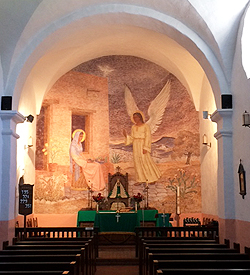 The town is home to many major historical sites among them the Presidio La Bahia. This mission is part of the group of Spanish missions that were built between 1632 and 1793 to provide protection for south Texas.
The town is home to many major historical sites among them the Presidio La Bahia. This mission is part of the group of Spanish missions that were built between 1632 and 1793 to provide protection for south Texas. 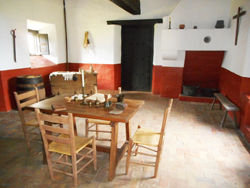 Countless missions were abandoned and even the location of some of them has been lost. Those that survived have provided a lasting influence on the state. La Bahia has been restored to its original 1836 look. The inside of the quaint chapel is known for its original groin vaulted ceiling and for the beautiful fresco painted by Antonio Garcia. The officers' quarters house a history museum that offers exhibits, artifacts, and a documentary movie. La Bahia demonstrates the influence that the Spanish and Mexican culture had on the story of Texas.
Countless missions were abandoned and even the location of some of them has been lost. Those that survived have provided a lasting influence on the state. La Bahia has been restored to its original 1836 look. The inside of the quaint chapel is known for its original groin vaulted ceiling and for the beautiful fresco painted by Antonio Garcia. The officers' quarters house a history museum that offers exhibits, artifacts, and a documentary movie. La Bahia demonstrates the influence that the Spanish and Mexican culture had on the story of Texas.
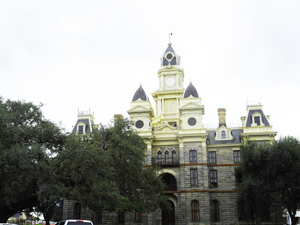 After visiting La Bahia we drove to the downtown area. The most interesting thing about traveling through small towns is seeing the beautiful architecture of the courthouses and the Goliad County Courthouse was no exception. The building was constructed in 1894 and designed by the English architect, Alfred Giles. The original clock tower and turrets were destroyed in a 1942 hurricane and were finally replaced in 2003. The green area around the courthouse is home to the infamous Hanging Tree, a Texas historic landmark.
After visiting La Bahia we drove to the downtown area. The most interesting thing about traveling through small towns is seeing the beautiful architecture of the courthouses and the Goliad County Courthouse was no exception. The building was constructed in 1894 and designed by the English architect, Alfred Giles. The original clock tower and turrets were destroyed in a 1942 hurricane and were finally replaced in 2003. The green area around the courthouse is home to the infamous Hanging Tree, a Texas historic landmark. 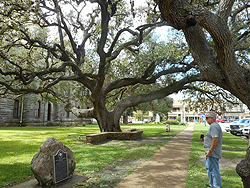 This tree represents the swift justice of the day that was meted out Texas style. For several years, court trials were held under the big oak tree and death sentences were concluded usually within a few minutes. Some estimates range in the low hundreds on the number of men who died on The Hanging Tree; such a beautiful old tree to have such a violent history. Looking at the tree, I noticed a rope hanging down from one of the branches. I wondered if that could have been one of the original hanging ropes but decided it was probably just there for effect - or maybe not. After seeing a place where so many men who lived by the gun died by the rope,
This tree represents the swift justice of the day that was meted out Texas style. For several years, court trials were held under the big oak tree and death sentences were concluded usually within a few minutes. Some estimates range in the low hundreds on the number of men who died on The Hanging Tree; such a beautiful old tree to have such a violent history. Looking at the tree, I noticed a rope hanging down from one of the branches. I wondered if that could have been one of the original hanging ropes but decided it was probably just there for effect - or maybe not. After seeing a place where so many men who lived by the gun died by the rope, 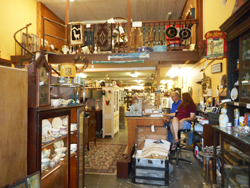 I felt a change was needed. What better change than to visit an antique shop and "browse" for a while. We found a wonderful shop fittingly named Hanging Tree Antiques right across the street. It was packed with everything that I really needed. The owners were exceptionally nice and friendly and before long I found a large, old jug that probably had been used to store liquor. Oddly enough, the jug was made by the Marshall Pottery company in Marshall, Texas. The last Graytripper trip had been to Marshall and I began to think that all Texas communities are linked by the 6 degrees of separation theory and that the Graytripper was a part of that link. After my purchase, Scott and I decided that it was time to begin our journey back to Houston.
I felt a change was needed. What better change than to visit an antique shop and "browse" for a while. We found a wonderful shop fittingly named Hanging Tree Antiques right across the street. It was packed with everything that I really needed. The owners were exceptionally nice and friendly and before long I found a large, old jug that probably had been used to store liquor. Oddly enough, the jug was made by the Marshall Pottery company in Marshall, Texas. The last Graytripper trip had been to Marshall and I began to think that all Texas communities are linked by the 6 degrees of separation theory and that the Graytripper was a part of that link. After my purchase, Scott and I decided that it was time to begin our journey back to Houston.
There are many other historic sites in the area to see such as the Zaragoza House, the birthplace of General Ignacio Seguin Zaragoza who was a hero of Cinco de Mayo. Nearby Goliad State Park will teach you all about ranching and why Goliad is considered the Birthplace of Texas Ranching. Inside the park, you can visit Mission Espiritu Santo or if you prefer a more leisurely activity, try paddling along the San Antonio River. All in all, Goliad is a wonderful place to visit and explore and I'm sure there are a lot of nice places to eat for people not traveling with their son.
This trip reinforced the Texas blood running through my veins. The amount of history and the beauty of the various missions and churches gave a boost to my heritage. Standing on the grounds of La Bahia, sitting in the church in Panna Maria, or walking through the museum in Gonzales provided an insight into the way of life during the time when emigrants from Europe came here searching for a better way of life for themselves and their families. One can only image the hardships they endured, the demanding work of making a living from the soil, and the fear of attack by hostile groups in the area. My ancestors came to Bastrop in 1841 from Germany seeking a better way of life. Through their determination, they were able to build a life, a family, and a society that has survived today. I applaud the strength of the early pioneers of our state. I sometimes wonder if I could have done the same thing. So "Remember Gonzales, Remember Panna Maria, and Remember Goliad!" Take the trip and learn more about the wonderful State of Texas and its people!
Anyplace you would like to See? Let me know and we will try to put it on our schedule. Go to the CONTACT US page and email the information or any comment you have about the trips that have been featured. We always want to hear from our friends and neighbors!